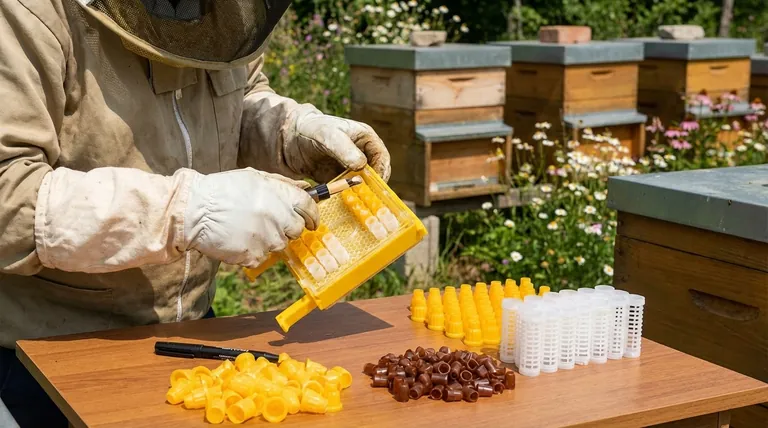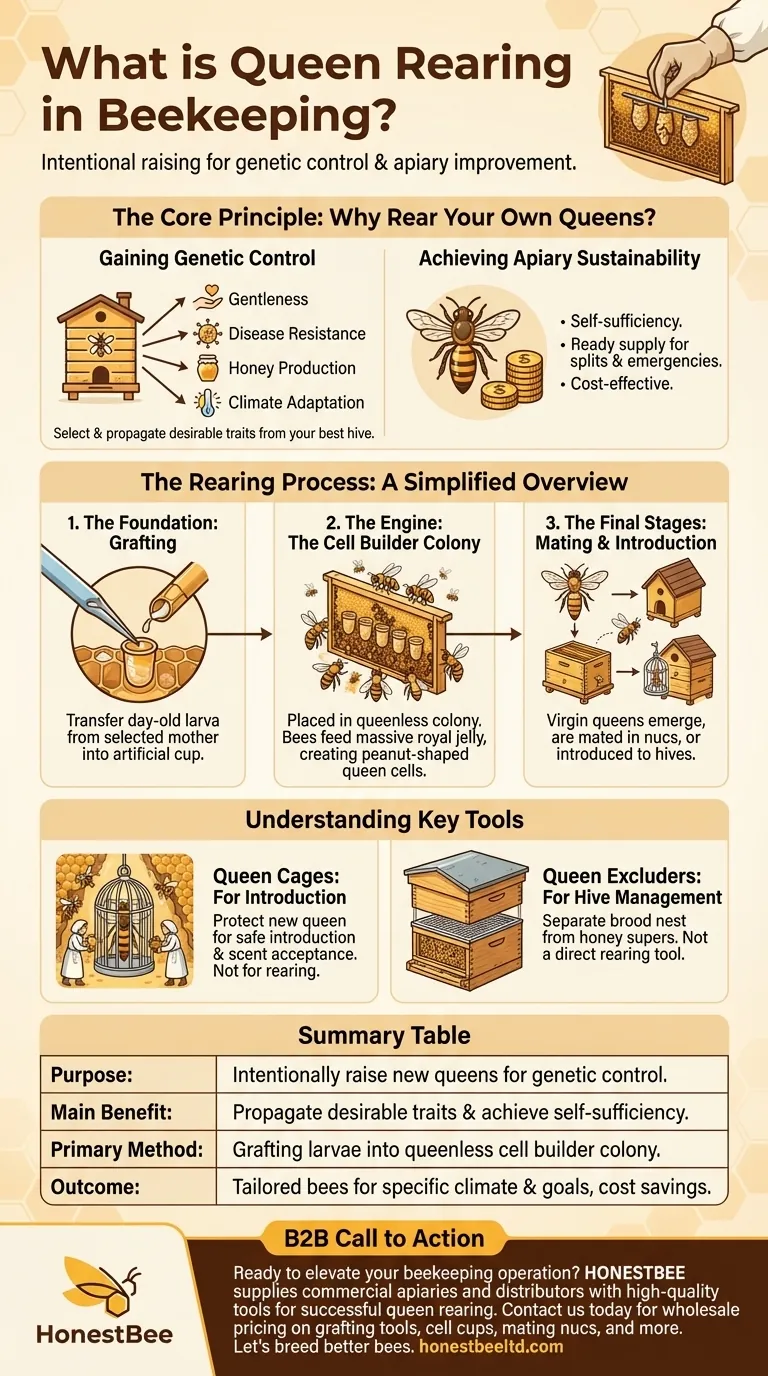In short, queen rearing is the process where a beekeeper intentionally raises new queen bees from their own hives instead of buying them. It involves carefully selecting larvae from a desirable mother queen and creating specific conditions within a colony to trick the bees into feeding these chosen larvae the special diet—royal jelly—that turns them into queens.
Queen rearing is fundamentally about taking control of your apiary's genetics. By deciding which bees get to reproduce, you can actively breed for specific traits like gentleness, disease resistance, and honey production, moving from simply keeping bees to actively improving them.

The Core Principle: Why Rear Your Own Queens?
For a beekeeper, the queen is the genetic heart of the colony. Her traits dictate the behavior, health, and productivity of her tens of thousands of offspring. Relying on purchased queens means accepting the genetic lottery of an outside supplier.
Gaining Genetic Control
The primary driver for queen rearing is to improve your bee stock. You can select larvae from your most gentle, productive, or mite-resistant hive.
By rearing queens from this "mother," you propagate those desirable genetics throughout your apiary, creating colonies better suited to your specific climate and management goals.
Achieving Apiary Sustainability
Relying on purchased queens can be expensive and logistically challenging, especially if you need a queen on short notice.
Rearing your own queens makes you self-sufficient. It gives you a ready supply for making splits (creating new hives) or for replacing failing or lost queens in an emergency, preventing a colony from becoming a non-productive "dud."
The Rearing Process: A Simplified Overview
Queen rearing leverages the bees' natural instinct to create a new queen when they sense they are queenless. The beekeeper simply guides this process with precision.
The Foundation: Grafting
The most common method involves a technique called grafting. The beekeeper uses a special tool to gently lift a day-old larva from a regular worker cell.
This larva is then transferred into a small, artificial wax or plastic cup, which mimics the base of a queen cell. Dozens of these can be prepared at once.
The Engine: The Cell Builder Colony
These grafted cups are placed into a powerful, populous "cell builder" colony. This hive is intentionally made to believe it is queenless.
Driven by survival instinct, the worker bees will immediately begin feeding the grafted larvae massive amounts of royal jelly, the protein-rich food that triggers development into a queen instead of a worker. They will build out the large, peanut-shaped queen cells around your artificial cups.
The Final Stages: Mating and Introduction
After about 10-12 days, the virgin queens are ready to emerge. They are either placed into small "mating nucs" (small hives) to fly out and mate, or the sealed queen cells are transferred directly to queenless hives that need them.
Once a queen has successfully mated and begun laying eggs, she is a proven asset.
Understanding Key Beekeeping Tools
The references mention several tools often associated with queens. It's critical to understand their specific roles, as they are not all directly used for the rearing process itself.
Queen Cages: For Introduction, Not Rearing
A queen cage is a small box used to safely introduce a new queen to a colony. Whether you've reared the queen yourself or purchased her, she is a stranger to the hive.
The cage protects her from the workers, who would otherwise see her as an intruder and kill her. It allows her scent (pheromones) to spread through the hive for several days, leading to gradual acceptance before she is released.
Queen Excluders: For Hive Management
A queen excluder is a screen with gaps large enough for worker bees to pass through, but too small for the larger queen.
Its primary purpose is to separate the brood nest (where the queen lays eggs) from the honey supers (where bees store surplus honey). This is a management tool to ensure honey can be harvested without brood in the frames. While it can be used to help set up a cell builder colony, it is not a direct part of the rearing process itself.
Making the Right Choice for Your Apiary
Deciding whether to rear queens is a significant step that depends entirely on your goals and experience level.
- If your primary focus is learning basic beekeeping: Concentrate on hive health and mastering the skill of safely introducing a purchased queen using a cage.
- If your primary focus is self-sufficiency and genetic improvement: Queen rearing is the definitive next step to create bees perfectly adapted to your environment and goals.
- If your primary focus is rapid expansion: Having a steady supply of your own queens is the most cost-effective way to make splits and grow your number of hives.
Ultimately, mastering queen rearing transforms you from a bee-keeper into a bee-breeder, giving you direct control over the health and future of your apiary.
Summary Table:
| Key Aspect | Description |
|---|---|
| Purpose | Intentionally raise new queens to control genetics and improve colony traits. |
| Main Benefit | Propagate desirable traits like gentleness, disease resistance, and honey production. |
| Primary Method | Grafting larvae into artificial cups placed in a queenless cell builder colony. |
| Outcome | Self-sufficiency, cost savings, and tailored bees for your climate and goals. |
Ready to elevate your beekeeping operation?
Mastering queen rearing is key to building a sustainable, productive apiary. HONESTBEE supplies commercial apiaries and beekeeping equipment distributors with the high-quality tools needed for successful queen rearing and hive management.
Contact us today to discuss wholesale pricing on grafting tools, cell cups, mating nucs, and other essential equipment. Let's help you breed better bees.
Visual Guide

Related Products
- Jenter Queen Rearing Kit Complete Set for Bee Breeding
- No Grafting Queen Rearing Kit: System for Royal Jelly Production and Queen Rearing
- Nicot Queen Rearing Kit for Beekeeping and Grafting in Nicot System
- Durable Galvanized Steel Spring Queen Bee Cage
- Brown Nicot Queen Cell Cups for Breeding Queen Bees Beekeeping
People Also Ask
- What were the size differences among queens reared from worker larvae? Maternal Origin Determines Queen Size
- How can beekeepers start a honey bee breeding program? Build a Superior, Resilient Apiary
- What is the timeline for queen breeding? A 28-Day Guide from Egg to Laying Queen
- What are the stages involved in queen raising? A Guide to Controlled, High-Quality Queen Production
- What genetic pathways differ in QE-queens? Unlocking the Master Controls of Queen Bee Biology



















